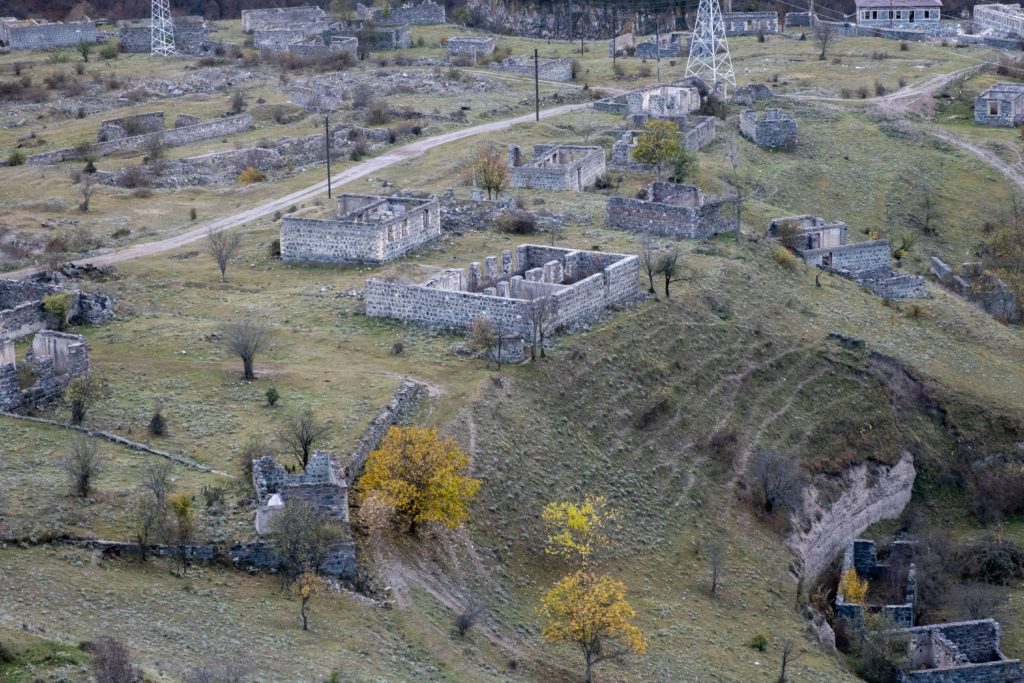BAKU
By LADA YEVGRASHINA
Azerbaijan says its troops came under attack on Thursday, the biggest uptick in fighting since a Moscow-brokered armistice late last year.
Baku said Shusha, Azerbaijan’s “cultural capital” and a historic mountainside city known for producing writers and scholars, and the crown jewel recovered by Azerbaijan after the years of Armenian occupation, came under attack from illegal Armenian armed groups using machine guns and automatic rifles, according to the defence ministry. It reported no casualties.
In a separate incident, Azerbaijan also reported its forces came under fire along the edges of its exclave of Nakhchivan. It says one soldier was wounded and evacuated for medical attention.
Armenia’s defence ministry – and what remains of the rump separatist entity it backs in the former Karabakh district – said it had nothing to do with any attacks.
Azerbaijani President Ilham Aliyev warned although Baku has already retaken most of the occupied lands, it might have to resort to more force to bring a full conclusion to the war in light of the latest events.
“We should be ready for war at any time,” he said. “But I am getting information that there is more talk that the conflict is not settled. This is a very mistaken and risky path,” he said during a meeting with war veterans in Baku.
He repeated his call for border delimitation and a full peace agreement.
“The sides should acknowledge each other’s territorial integrity, borders and give a start to the delimitation work,” Aliyev continued. International organisations are also giving positive signals on delimitation. If Armenia does not want that, it’s their deal. But they should think really hard about what will come after,” he said.
While the armistice has held and Azerbaijan got most of what it wanted during its final offensive, there are other outstanding issues.
The separatists in the former predominantly ethnic Armenian Soviet Autonomous District of Azerbaijan’s Nagorno-Karabakh still cling to a reduced part of the region. However, it is isolated – accessible only via Azerbaijan – and has a tiny population of only an estimated 25,000-50,000 people and little economic potential. Baku says it has no status and does not exist formally.
And there is still no progress in re-opening a rail and road-route between the Azerbaijani Nakhchivan exclave and the rest of the country via a 40-km strip of Armenia.
There were some thought-provoking elements in the wording of the government statement concerning the alleged firing on Shusha. The defence ministry said the fire came “from the direction of areas in Azerbaijan where Russian peacekeepers are temporarily located”. However, it did not accuse the 2,000-strong Moscow peacekeeping force of any involvement in the incident.
But many Azerbaijani analysts and commentators have argued that Russian troops based in Armenia may have fired rockets at Azerbaijani positions in Shusha during the waning days of the war.
NATO member Ankara and Moscow operate a joint “monitoring centre” in the looted, destroyed city of Agdam, which the Armenians systematically dismantled. Turkey was not explicitly mentioned in the formal November 10 armistice, raising speculation that the Kremlin only reluctantly accepted the Turkish NATO presence. Turkey helped Azerbaijan build its army virtually from scratch over 25 years after it had lost many districts to the Armenians. And the final six weeks of the war was a total rout, with Azerbaijan using sophisticated “suicide drones” and a deft military strategy to decimate the Armenians, who, as members of the Moscow-led Collective Security Cooperation Organisation (CSTO), were using outdated World War Two style trenches and old-style tactics.
Moscow refused to provide any active overt military aid at that stage as it acknowledged that the fighting was taking place on internationally recognised Azerbaijani territory.
Armenia did hand over some important maps of areas it heavily sown with landmines during its long occupation, though the layout of other areas is still a matter of contention. And still, others may have been hastily booby-trapped in such a way that no one may know where the death traps are. This greatly impedes the return of more than 600,000 Azerbaijanis to the now de-occupied but looted and destroyed territories.
While few analysts believe the ongoing tensions could erupt into a new full-scale war, the lack of a full peace agreement and the failure to establish diplomatic relations are destabilising. They prevent a full-scale peace agreement and the establishment of diplomatic relations.
Armenia Prime Minister Nikol Pashinyan was forced into a snap election on charges he had “lost” the occupied territories. Still, his ruling bloc won a resounding victory in June, in a clear signal of war fatigue. The 46-year-old writer and journalist said Armenia had no choice but to seek peace.
He long argued Armenia had no chance of holding the devastated lands and accused detractors, who never volunteered to fight, of hypocrisy.
Since Pashinyan won elections in 2018 during a “velvet revolution”, several high-level military officers have been arrested for massive corruption, down to hoarding stashed army rations meant for front-line, mostly young soldiers.
Pashinyan’s handover of landmine maps includes 300,000 disclosures of hidden anti-tank and anti-personnel mines in the areas of the former front-line areas of Agdam, Fizuli, and Zangelan have evoked threats against him of being a “traitor”. Experts say the mines, in addition to unexploded bombs, could take up to 15 years to clear.
The Organisation for Security and Co-operation in Europe (OSCE) led a largely ineffective three-decade mediation effort. Still, it was scoffed at for being ineffectual, financially costly, and in the end, failed to halt hostilities. Armenia ignored four UN Security Council resolutions from the early 1990s to stop occupying Azerbaijani territory and argues it simply had no choice but to implement them by force.

